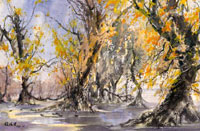Painter shows his class in Tibetan village
Updated: 2012-12-31 11:21
By Huang Zhiling in Chengdu (China Daily)
|
|||||||||||
 |
|
Professor Wang Qijun (right) of the China Central Academy of Fine Arts shows how life has improved in Sichuan's Tibetan areas. Photos provided to China Daily |
A group of women and children gather in a remote village square in Shiqu county, Sichuan's Garze Tibetan autonomous prefecture.
The children all have books in their hands, which arouses the attention of artist Wang Qijun.
The 58-year-old professor of the Beijing-based China Central Academy of Fine Arts follows the kids into a temple as they sit in front of a Buddha statue, attended by a lama in a red robe.
Preoccupied with their studies the students ignore him as the sunlight streams in through a window and inspires Wang to paint, Tibetan Class in the Village.
The painting is one of many Wang has done in the wake of his trip to the Tibetan-inhabited areas of Sichuan in December 2011.
|
 |
Together with Tian Haipeng, vice president of the CCAFA, Wang led a delegation of painters from the academy for a week-long trip to the area, where they visited Tibetan villages and talked to local art students.
Situated on the plateau 3,000 to 4,000 meters above sea level, Sichuan's Tibetan areas used to be poor but have improved economically in recent years, which is reflected in Wang's oil paintings.
Walking on a country road in Ma'nai village, Jinchuan, Wang sees a young mother carrying her child and walking under the sun.
"The intense sunlight turned the mother and child into glowing colors and I felt the warmth of maternal love and did the oil painting Heart Filled with Love."
This was not Wang's first visit to Tibetan-inhabited areas: "I visited as a painter for the first time in 1985. That year, I went through Gansu and Qinghai provinces to enter Tibet."
Roads were inaccessible and the long-distance bus could travel only about 200 km in a single day.
"When we were near Qinghai Lake, 3,300 meters above sea level, the bus broke down. The Tibetan driver spent more than five hours repairing it. As I could not speak Tibetan, I had to wait patiently and we had no water to drink," Wang recalls.
When he visited a farming area in southern Tibet in 1997, Wang could readily appreciate all the changes taking place.
"Many Tibetan children attended schools in big cities like Beijing and Shanghai. The State paid for their education. When I talked with their parents, the children could speak fluent Mandarin and interpret for us," he says.
|
 |
He saw further improvements in living standards during his visit in December 2011. Herdsmen had fixed up their residences and they all had TV sets and cell phones, Wang says.
He says that when he visited a Ganbao Tibetan village square in Lixian county, Sichuan's Aba Tibetan and Qiang autonomous prefecture, locals were celebrating the Tibetan New Year.
"When I chatted with an old Tibetan woman, her son called from outside their hometown.
"I instantly felt what a happy life meant. It became the inspiration for the oil painting Message of Spring," Wang says.
huangzhiling@chinadaily.com.cn
Related Stories
Culture gets helping hand in Tibet 2012-12-29 08:01
Tibet Opera to return to center stage 2012-12-28 03:06
An abiding love for Tibet 2012-12-25 07:55
Tibet encourages airlines to open new routes 2012-12-17 16:36
Tibet school finds that pairings remove barriers 2012-12-17 12:05
Today's Top News
Rescuers race against time for quake victims
Telecom workers restore links
Coal mine blast kills 18 in Jilin
Intl scholarship puts China on the map
More bird flu patients discharged
Gold loses sheen, but still a safe bet
US 'turns blind eye to human rights'
Telecom workers restore links
Hot Topics
Lunar probe , China growth forecasts, Emission rules get tougher, China seen through 'colored lens', International board,
Editor's Picks

|

|

|

|

|

|





